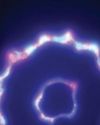
Shinji Suzuki met Takuo Toda in 1999, atop Mt. Yonami in the southern city of Jinseki-Kogen, Japan. Toda, the chairman of the Japan Origami Airplane Association, was there to launch a large paper plane from a tower he had built on the mountaintop for just that purpose.
Toda persuaded the local city council to build the 85-foot-tall tower-with 360-degree views of Mount Daisen, Mount Dogo, and the Hiba Mountains-as a monument to paper airplane hobbyists. The first floor of the tower includes a showcase of precisely folded paper plane models, while the top floor opens into a veritable launch pad.
When Suzuki first met Toda, he was launching the almost-seven-foot-long paper plane-modeled after the space shuttle Discovery-off that very flight deck. "He told me that he would like to launch this paper plane from the space station," Suzuki, now an emeritus professor in aviation at the University of Tokyo, says. "Everybody laughed at him."
Toda's lofty dream inspired Suzuki to take action, and in 2008, the pair announced a project to launch paper airplanes from the International Space Station (ISS). Critics suggested these planes would burn up on their descent back to Earth, Suzuki says. However, he predicted that with a protective coating and a controlled trajectory, they might actually be able to avoid burning up on reentry into Earth's atmosphere. Another challenge? Figuring out where exactly the planes would land.
While Suzuki plotted the planes' journey to the ISS, Toda would chart another path, racking up Guinness World Records for his paper airplane designs. For decades, he's aimed to break the 30-second record for time aloft of a paper plane. He's come close multiple times.
This story is from the {{IssueName}} edition of {{MagazineName}}.
Start your 7-day Magzter GOLD free trial to access thousands of curated premium stories, and 9,000+ magazines and newspapers.
Already a subscriber ? Sign In
This story is from the {{IssueName}} edition of {{MagazineName}}.
Start your 7-day Magzter GOLD free trial to access thousands of curated premium stories, and 9,000+ magazines and newspapers.
Already a subscriber? Sign In

ONE OF THE 'GREATEST THREATS' TO THE PACIFIC NORTHWEST ISN'T WHAT YOU THINK.
EXPERTS ARE PREPARING THE REGION AGAINST THE THREAT OF DANGEROUS VOLCANIC MUDFLOWS, KNOWN AS LAHARS, WHICH COULD INUNDATE THE COMMUNITIES SURROUNDING MT. RAINIER IN AS LITTLE AS 30 MINUTES.

THE WORLD'S TOUGHEST ROW
They rowed 3,000 miles across the Atlantic, battling unpredictable weather, chaotic seas, and finicky equipment. But what they discovered gave them profound new insights into the power of the ocean.

HOW TO DIY OFF-GRID SOLAR
SPEND THE TIME UP FRONT AND PLAN IT CAREFULLY TO AVOID DISAPPOINTMENT

Are We on the Verge of an ARMS RACE in SPACE?
RUMORS OF A RUSSIAN SPACE NUKE, ALONG WITH OTHER SATELLITE-TARGETING WEAPONS, HAVE MADE GEOPOLITICAL TENSIONS EXTEND INTO ORBIT.

Fresh Fingerprints on an Ancient Statue
A CLAY FIGURINE HAS SPENT MILLENNIA incomplete, waiting at the bottom of a lake for its long-dead craftsman to finish the Iron Age-era statuette.

Quantum Entanglement in Our Brains
IT HAS LONG BEEN ARGUED THAT THE human brain is similar to a computer. But in reality, that's selling the brain pretty short.

The Tools of Copernicus
WAY BACK IN 1508, WITH ONLY LIMited tools at his disposal, Nicolaus Copernicus developed a celestial model of a heliocentric planetary system, which he described in hist landmark work De revolutionibus orbium coelestium. It was a complete overhaul of our conception of the universe-one that, unfortunately, earned him the ire of the Catholic church for decades after his death-and forever changed the way we look at the stars.

Building a Sixth-Generation Bomber Raptor
THE GLOBAL COMBAT AIR Programme (GCAP)-a project by the U.K., Italy, and Japan to develop a sixth-generation stealth fighter-has been busy at the drawing board reshaping its vision of the future of air warfare. And judging by the new concept model unveiled at this year's Farnborough air show, that future has big triangular wings.

The Electroweak Force of the Early Universe
TODAY, THE UNIVERSE AS WE KNOW IT IS governed by four fundamental forces: the strong nuclear force, the weak nuclear force, electromagnetism, and gravity.

This Ancient Fossil With a Brain and Guts
WE KNOW WHAT FOSSILS LOOK like. For example, typical dinosaur fossils are bones turned to stone and preserved from the passage of time, located, if we're particularly lucky, in large collections that can be reassembled to represent the beast they used to prop up in their entirety.